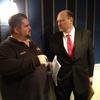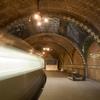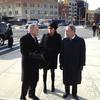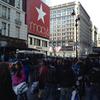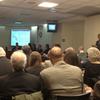Jim O'Grady appears in the following:
My Test of the MTA’s Real-Time Bus System on Staten Island
Thursday, January 12, 2012
The MTA said there are three ways to use real-time bus information known as Bus Time: Click it. Text it. Scan it. I went to three bus stops in Staten Island to try it on Wednesday, the day it launched in the borough.
Trying Out Bus Time
Wednesday, January 11, 2012
Some 757 buses in Staten Island will now tell you where they are. The NY MTA has installed GPS devices in the buses, at a cost of $7 million, and after what it says are 6 years of development.
The MTA says there are three ways to use Bus Time: Click it. Text it. Scan it. I went to three bus stops in Staten Island to try it.
(Staten Island Borough President James Molinaro says he's concerned about seniors without mobile phones, so he's kicking in some $200,000 to add countdown-clock like displays at bus stops.)
The MTA's instructions say, "From a desktop or a smartphone, customers can enter the bus route, intersection or bus stop code and get a map showing where the buses are along the route and how close the next bus." In my test, doing those three things got me an accurate and comprehensive list of local and express buses that use the nearest stop.
And a nifty map popped up on my laptop showing the location of those buses as they came toward me. But not so when I used my phone. No map appeared, and I couldn't see a way to bring one up.
Using my phone to text an intersection, address or bus stop code to 511123 also brought me a list of buses and how far away they were: 0.7 miles, 1.5 miles, etc. It did not say how many minutes it would take for each to arrive. It's up to riders to judge the speed of an approaching bus based on traffic and time of day.
I wanted to see how clearly the numerical bus codes were displayed at stops but couldn't do that because the MTA says it will take another several weeks to install all of them in Staten Island. For now, riders must go to www.mta.info/bustime to find the code they need or text the nearest intersection to 511123 to have it sent to them. Then text the number for real time bus information.
Q&A | MTA Chief Joseph Lhota on Improving the MTA’s Image
Tuesday, January 10, 2012

MTA Chief Joseph Lhota believes the Metropolitan Transportation Authority deserves more respect. Confirmed Monday by the New York State Senate, Lhota’s main goal seems simple enough on paper: getting the public not to hate on the nation’s largest transit agency.
NY MTA Contract Talks With Union Delayed
Wednesday, January 04, 2012
TWU Local 100 president John Samuelsen and NY MTA executive director Joe Lhota before start of contract talks. (Photo by Jim O'Grady)
(New York, NY - WNYC) The NY Metropolitan Transportation Authority and its main union have cancelled a bargaining session only ten days before their labor contract is to expire.
The heads of the union and the NY MTA were supposed to hold their first face to face talks on Thursday. But that probably won't happen until after NY MTA executive director Joe Lhota has his confirmation hearing before the State Senate on Monday.
Lhota is expected to be confirmed as chairman and CEO of the NY MTA. That should put him in a better position to strike a deal with Transport Workers Union Local 100 president John Samuelson.
Both sides say preliminary talks have gone fairly well. Gone is the animosity that Samuelson, a track worker, felt toward former MTA chief Jay Walder. One union official described the problematic relationship this way: "Walder condescended to John, like he still had steel dust under his fingertips. But John feels Lhota is genuine and honest."
At least that's the feeling for now. The two sides will probably need to agree that any pay raises over the next three years be offset by measurable productivity gains or benefit cuts.
For example, the NY MTA is asking the TWU to allow a combining of the train conductor and train operator jobs. New hires would be trained to do both tasks, allowing the authority to pay fewer workers to stand in reserve in case an operator / conductor misses work because of sickness or some other reason.
That's just one of many issues to be worked out in a negotiation that has begun well but which neither side expects to be easy.
MTA Contract Talks With Union Delayed
Wednesday, January 04, 2012

The MTA and its main union have canceled a bargaining session ten days before their labor contract is set to expire.
Unfulfilled Trains
Tuesday, January 03, 2012
Jim O'Grady, WNYC's transit reporter, talks about New York City's abandoned subway stations.
New York's Lost Subways (Complete with Map and Dusty Pics)
Tuesday, January 03, 2012
Click image for full size interactive map.
(WNYC -- New York, NY) (EDITOR'S NOTE: Some older browsers can't open the map. Try updating your browser or try a different one.)
The New York City subway system has 842 miles of track, making it the largest in North America. And there's even more to it than riders see: dozens of tunnels and platforms that were either abandoned or were built but never used. They form a kind of ghost system that reveals how the city's transit ambitions have been both realized and thwarted.
Historian Joe Cunningham knows as much as anyone about the subway and how it's evolved since it opened in 1904. He stood before a map of it on a wall in Penn Station and considered its extent. The system is vast, reaching like an octopus from Manhattan to almost every neighborhood outside Staten Island. Cunnningham said that's because its planners have always thought big.
Subway historian Joe Cunningham (photo by Jim O'Grady/WNYC)
"Oh yeah, it was a bold undertaking and little by little it just grew over a period of about 45 years," he said. He also pointed out the gaps in service: southeast Brooklyn, central and eastern Queens, straight up the middle of the Bronx.
Almost all of those neighborhoods were set to get their own subways. Most of those lines died on the drafting table, but some were begun and then abandoned when the city ran out of money or pursued other priorities.
"After World War II, prices had gone up substantially and it became obvious that it was not going to be possible to build all of the lines they would've like to have built," he explained.
Urban Explorers Head Underground
Unused tunnel under Nevins Street Station in Brooklyn. (Courtesy of Steve Duncan)
You can see their beginnings, if you go underground. That's where urban explorers like Moses Gates likes to go. (Gates is working on a book, which is to be published by an imprint of Penguin Books and has the working title, "The Other Side of the Sign: About Urban Exploration Around the World.") He took me down to a tunnel under Nevins Street in Brooklyn, where a line was begun that would've run from Downtown Brooklyn in two directions: east into Bedford-Stuvesant and west under Flatbush Avenue in Fort Greene and then over the Manhattan Bridge to Canal Street.
Urban explorer Moses Gates
It lies beneath tracks for the 4 and 5 trains, which rumbled overhead as we stood on a fully tiled platform that never opened to the public. To get there, we hopped down on some tracks that were closed for repairs and made our way to a tunnel begun for the abandoned line. Shadowed and cavernous, it was swampy in places and layered with grit in others. All of it sits beneath the city, unused.
Back above ground, Gates said the system is honeycombed with spots like this: stations, platforms and tunnels prepared for an expansive future that never came to be.
"There's these cool little remnants of foresight that didn't pan out," he called them.
For example, a Brooklyn-bound branch of the F train was supposed to keep going under Houston Street, beneath the East River and across Central Brooklyn before turning down to Flatlands near Jamaica Bay. That area still doesn't have a subway.
A large station for that never-built line was constructed under South Williamsburg. Two summers ago, graffiti artists from around the world snuck in and covered its concrete walls with giant works of art.
"We built the subway into farmland on the assumption that people would live there and use them to get to work," Gates said, including tunnels and stations readied to accommodate future lines. "We built a humongous shell station on the G line, or right off the G line, because there was gonna to be two other lines and two new tunnels under the East River that were going to converge there."
One of them would've been that F train branch, another would've been an extension of the Eight Avenue line (A/C) that cut across Lower Manhattan and into Brooklyn.
"This goes on in the '20s and '30s," Gates said. "Then, the Depression in the '30s, the city runs out of money and none of this gets built."
As Gates described it, these unbuilt lines make up an impressive second system that sits invisibly on the actual subway map: lines that would've directly connected Forest Hills to JFK Airport, South Brooklyn to Staten Island and the Second Avenue Subway to Throgs Neck in the Bronx.
"Ever since, you've had all these cool nooks and crannies all around the subway system that were kind of foresight that never panned out," he said.
A Look at One Forgotten Station
Spur beneath Grand Central Terminal used by FDR's special train car. (Courtesy of Steve Duncan)
The MTA doesn't want people exploring the abandoned or lost station stops. But for those that want a first hand glimpse, there is one option. MTA worker Dan Brucker gives tours of Grand Central Terminal that feature a visit to a secret station far below ground.
"That secret train station out there was built for one customer only," he boomed to a tour group late last year under the vaulted constellation of the terminal's main hall. "It was built for Franklin Delano Roosevelt."
He said Roosevelt's custom-built train would pull in and open its doors. A limousine with the president in it would be driven from inside the train, down a ramp and into an elevator next to the platform.
"He and his limousine and his staff would be lifted up and then backed out into the Grand Ballroom of the Waldorf Astoria," he said, where the president would give a speech.
FDR's train car still sits on a stub of track beneath Grand Central, a peculiar piece of the city's lost transit system — like stations once opened and now closed.
President Franklin Delano Roosevelt's custom-built train car, which sits on a secret track beneath Grand Central Terminal. (Courtesy of Steve Duncan)
Glimpses While Riding the Line
Take the 1, 2 or 3 train and you can see an abandoned station at West 91st Street. In the 1950s, the city increased the capacity of the system by lengthening the average train from eight to ten cars and expanding station platforms. More riders could move through a commute. But to increase the speed of the trains, more space was needed between stations along the old routes. The city shut down 16 stops.
The best known one in Brooklyn is at Myrtle Avenue on the Q line, which has been turned into a work of art called masstransitscope. In Manhattan, there are abandoned stations at Worth Street, East 18th Street and beneath City Hall.
Some of those lost stops hide in plain sight — graffiti-covered indentations lit by a few bare bulbs and glimpsed from a moving train. All you need is to know where to look.
City Hall station. An elegant station on a tight curve that served as the original southern terminus of the 4,5,6 line – closed in 1945 after trains were lengthened and the nearby Brooklyn Bridge Station was expanded. http://bit.ly/qHufe (Courtesy of Shane Perez)
Unused tunnel under Atlantic Avenue in Brooklyn. (Courtesy of Steve Duncan)
Tunnel under Atlantic Avenue in Brooklyn. (Courtesy of Steve Duncan)
Unused part of the Second Avenue Subway. (Courtesy of Shane Perez)
Abandoned subway at E 18th Street in Manhattan. (Courtesy of Shane Perez)
Tunnel under Bergen Street in Brooklyn. (Courtesy of Steve Duncan)
This article also appears on WNYC , where a radio version of this story can be heard.
All photos used with permission, do not repost them without owner's permission.
For more stories like this follow Transportation Nation on Twitter, sign up for our RSS Feed or like us on Facebook.
Inside the City's Ghost Subway System
Tuesday, January 03, 2012

New York Traffic Deaths Hit Historic Low
Thursday, December 29, 2011
NY Police Commissioner Ray Kelly, NY DOT Commissioner Janette Sadik-Khan and NY Mayor Bloomberg Announce Traffic Stats at Grand Army Plaza in Brooklyn. (Photo by Jim O'Grady)
(New York, NY - WNYC) The Bloomberg Administration says the city will have the lowest number of traffic fatalities in its history this year.
Mayor Bloomberg said 237 people have been killed in traffic incidents this year--a 40 percent drop from 2001. He said traffic fatalities for pedestrians and children are also at record lows.
New York Transportation Commissioner Janette Sadik-Khan added that fatal bicycle accidents have held steady. She said that's despite a quadrupling of bike ridership over the past decade.
The mayor and his transportation commissioner unveiled the statistics in Brooklyn at Grand Army Plaza, where they said safety upgrades contributed to a 40 percent reduction in crashes over the past three years.
Sadik-Khan said deaths are down because the city keeps re-engineering its streets, and plans to do more. "You will see more pedestrian countdown signals," she said. "We're going to be doubling them in the next two years. You will see more neighborhood slow zones, continuing our work to create slow zones around schools. We've done 138 so far."
She said her department also plans to keep installing bike lanes, crossing lanes and pedestrian islands around the city.
New York's traffic fatality rate is already half the per capita national average.
New York Traffic Deaths Hit Historic Low
Thursday, December 29, 2011

The Bloomberg administration says the city will have the lowest number of traffic fatalities in its history this year.
After Christmas, Shoppers Swarm Manhattan
Monday, December 26, 2011

Christmas is over, but the shopping continued Monday as customers thronged Manhattan retailers.
Giants vs. Jets: Let The Trashtalk Begin
Friday, December 23, 2011

Football fans are getting ready for the Giants - Jets showdown on Saturday at Met Life Stadium in New Jersey. The game will likely decide which team makes it into the NFL playoffs, and which slinks off the local sports stage until next season.
Open Phones: Workshopping Your Holiday Stories
Thursday, December 22, 2011
Whether you celebrate one of the religious holidays or just a few days off from work, this time of year is a time to gather with friends and family. And chances are there will be lots of the same stories being told at your dinner table.
We open the phones for you to tell that classic family story - or try out a new one. Plus, WNYC reporter Jim O'Grady - a Moth StorySlam and GrandSlam winner - offers advice on how best to tell your tale. Call in with your story 212-433-9692!
Debate Breaks Out at Typically Tame MTA Board Meeting
Wednesday, December 21, 2011

The MTA likes to keep its disagreements behind closed doors. But with one comment, differences over $20 million burst forward into the board meeting on Wednesday.
Actual Debate Breaks Out At NY MTA Board Meeting
Wednesday, December 21, 2011
Perhaps the most boring photo ever taken of a NY MTA board meeting, where stuff went down. (Photo by Jim O'Grady.)
(New York, NY - WNYC) The NY Metropolitan Transportation Authority board was about to vote on its $12.7 billion budget for 2012 when member Allen Capelli spoke up and ground the proceedings to a halt. The moment was unusual because the board traditionally works out differences behind closed doors, making its public sessions a fait accompli machine.
Capelli proposed an amendment to the budget that would have the NY MTA spend $20 million to reverse some of last year's drastic cuts to subway, bus, and commuter train service.
Board member Charles Moerdler backed him up, saying it would show riders they could expect more from the MTA besides fare hikes
"If you care about public mass transit, put up or shut up," Moerdler said before comparing the amendment to apple pie and motherhood. "You cannot vote against it."
Opposed was budget director Robert Foran, who said next year's books were balanced on cuts to overhead that have yet to be identified.
"I don't know where we're going to get the $35 million that I just said we're going to cut," Foran explained with some exasperation. "I don't know where I'll get this $20 million."
He said the $35 million in cuts combined with $33 million in emergency reserves will be needed to plug an expected drop in revenues from the MTA's portion of a state payroll tax.
Foran noted projections that show a 30 to 40 percent drop in Wall Street bonuses this year, which provide a big slice of the payroll tax pie. "You're putting a $20 million burden on us," he said to Capelli and Moerdler, "when we're already trying to figure out what are we going to do when the whole payroll economy comes down."
Joe Lhota, the NY MTA's new executive director, also spoke against the amendment, which he described as a "dangerous proposal."
Board member Andrew Albert, who represents the New York City Transit Riders Council, disagreed. He called a budget without at least some restored service "a budget balanced on the backs of riders." He said certain buses, trains and subways needed to run as often as they did before last year's cuts. "We need to bring back the frequency so people are not packed in like animals," he said.
The debate raged a good half hour before a vote was called. The amendment lost 6 to 4. The rest of the 2012 budget--which includes no fare hikes or service cuts--was passed.
Lhota is expected to go before the State Senate next month for confirmation as chairman of the board. Should he gain the position, it will be interesting to see if debates keep breaking out during the MTA’s public sessions.
Cashless Tolling In NYC - Not Yet, But Moving Toward It
Tuesday, December 20, 2011
Model of the Throgs Neck Bridge, part of the Panorama of the City of New York at the Queens Museum of Art. (Photo by bankbryan / Flickr.
(New York, NY - WNYC) If the NY MTA is on a ten-mile march toward cashless tolling on its nine bridges and crossings, it has, roughly speaking, just passed the two mile mark and is going strong. But authority spokesman Judie Glave insists it could still quit any time.
That's a far cry from my report of yesterday, which declared the NY MTA ready to go the distance and put cashless tolling on all its crossings. It turns out I read too much into the words, "The pilot has been a success," spoken at a committee meeting yesterday by Don Spero, the authority's chief financial officer of bridges and tunnels.
He was referring to an experiment on the Henry Hudson Bridge, which connects the Bronx with the northern end of Manhattan.
In January, the MTA removed the gates from the bridge's EZ Pass lanes, which sped up toll collection while reducing congestion and pollution. Six months later, cash-paying drivers were given the option of buying an EZ Pass from a toll-taker at the bridge. Spero reported 7,500 tags had been sold in four months, boosting the bridge's EZ Pass usage by more than 5 percent.
The MTA will now be moving into Phase 2 of its pilot program on the Henry Hudson Bridge, which is instituting cashless tolling in the spring. Drivers will have two payment options: cruise through with their EZ Pass tag and pay $2.20 or have their license plate photographed and a bill for $4 mailed to their home.
That's the change I mistakenly thought was coming to all the crossings. In fact, cashless tolling will be tested on the Henry Hudson Bridge for about nine months and then evaluated. If all goes well, it could spread to the NY MTA's other bridges and tunnels: the Bronx-Whitestone, Throgs Neck, Verrazano-Narrows, Robert F. Kennedy, Cross Bay and Marine Parkway Bridges, along with the Brooklyn Battery and Queens Midtown Tunnels.
What will now become standard at those crossings is on-site sale of EZ Pass tags. Glave said the more drivers who use EZ Pass, the less it costs the authority to collect their tolls. And thanks to a change of contractor earlier this year, the NY MTA now pays $8.90 for each tag, down from $20.95. Spero said that alone saved the authority $9.3 million dollars on a recent bulk purchase.
Though the NY MTA is unwilling to commit to anything beyond a pilot program on one bridge, it seems safe to say the incentives for putting cashless tolling at all its crossing at some time in the future is already strong--and that would mark a major change in the way drivers pay to get around.
We'll keep you posted.
Straphangers Campaign Top-10 Worst (And Best) NYC Transit Moments of 2011
Monday, December 19, 2011
 (New York, NY - WNYC) - In 2011, New York transit riders were beset by fare hikes, rats, the loss of garbage cans and a full-on closure because of Tropical Storm Irene.
(New York, NY - WNYC) - In 2011, New York transit riders were beset by fare hikes, rats, the loss of garbage cans and a full-on closure because of Tropical Storm Irene.
But none of those events, according to subway advocacy group the Straphangers Campaign, was the No. 1 horrible thing that happened to transit this year. What's the worst thing that happened? A pair of maneuvers that make the financial structure of the nation's largest transit system more uncertain.
Here are the full list of best and worst transit events from the Straphangers' Campaign.
The top-10 worst:
10. A tax-free transit benefit may shrink in half next year. The program – which exempts up to $230 of wages used for transit from most taxes – was increased in 2009. The parking benefit is slated to go up to $240, while the transit benefit will fall to $125 unless Congress acts.
9. Passenger assaults on bus drivers and subway workers are up, 20 percent and 16 percent, respectively, this year.
8. Garbage can-less subway stations. As part of a larger initiative to address subway garbage disposal problems, a pilot to remove garbage cans from two stations got a poor response from the public.
7. Tropical Storm Irene. It could have been much worse. In stark contrast to the blizzard of late 2010, the City and MTA performed well here. But many New Yorkers experienced what the loss of transit service meant to the city that never sleeps.
6. Breakdowns increased and ridership decreased on city transit buses. The breakdown rate has worsened more than 11 percent and total ridership is 3 percent, as of September 2011. Reason given: an aging bus fleet and a December 2010 fare hike. The percent of city buses that were 12 years or older more than doubled in the past year.
5. MTA over budget and behind schedule on Second Avenue Subway and East Side Access, say federal officials. The MTA said that ESA and Second Avenue will be done by September 2016 and December 2016, respectively, while the Federal Transit Administration puts their opening dates at April 2018 and February 2018.
4. Aged trains on C line will now remain in service through at least 2017. They will be 53-years old, well past the tenure envisioned upon their gleaming debut during the Johnson Administration in 1964. The reason: shortfalls in capital revenues.
3. MTA proposed to take on $7 billion of debt for capital projects. With little hope of new funds, the MTA is proposing more borrowing to pay for its key rebuilding program. The result: half a billion in added interest payments a year, fueling pressure for higher fares to pay it back.
2. The state legislature voted exemptions to the MTA payroll tax at an unknown cost to its riders.
1. The state swept a net $100 million from dedicated transit operating funds. For the second year in a row, state government diverted money from accounts created to fund mass transit. The cuts add pressure to hike fares and cut service. Legislation to make it harder to raid dedicated transit funds passed both houses of the state legislature, but then was watered down.
Top-10 best:
10. More countdown clocks appear around the subways. New York City Transit set as a goal to install these highly popular displays at 153 stations on the No. 1 through 6 lines by December 2011. Another 24 are on the L and a simpler version is at 32 stations on lettered lines.
9. Cell phone service comes to six underground subway stations. Not everyone will agree that his is a good step. In a recent Straphangers Campaign opinion poll, riders voted 54 percent to 43 percent that this was a good idea. It’s important to note that riders for years have used cell phones at hundreds of stations above ground.
8. $1 fee on purchase of a MetroCard postponed. Supporters say it would reduce litter. Opponents see it as a fare hike and it’s not popular. The agency will hold off until 2013.
7. MTA adopted the 511 number for one-stop telephone help. Coupled with mta.info, this has the potential of providing better customer assistance at lower cost. But it still needs to be streamlined.
6. The southbound Cortland Street station on the R line re-opened. There was a grim time after 9/11 that a plywood, handwritten sign on the Cortlandt station in the shadow of the World Trade Center warned train operators, “Do Not Stop Here.”
5. Riders can now track the location of some bus routes by cell phone. “Bus Time” – which allows riders to get information on the location on buses on their cell phones – started on the B63 in February. By year’s end, it comes to all Staten Island bus routes. It’s convenient and encourages people to use buses.
4. MTA launched Weekender site. When you go to mta.info on Friday afternoons through Sunday evening, it becomes the Weekender, with easy-to-understand maps describing what most weekend visitors want to know: how will my commute be affected by transit construction and repair projects
3. Some of the service cuts from last year were restored in 2011. Weekend M50 bus service in midtown was re-instituted, as was the X36/38 express bus from Bay Ridge to Manhattan.
2. Faster bus service arrived on the M34. This year, M34 passengers got to pay their fares before boarding, speeding up service on this notoriously slow route – if there’s good rider education on the new fare system.
1. There was no subway, bus and commuter fare hike after three years-in-a-row of increases. The fare went up in 2008, 2009 and 2010 – but not in 2011. That was good news for cash-strapped riders in a harsh economy. But the MTA already says it needs a higher fare by the end of 2012.
The MTA declined comment.
Port Authority Chief Expects Building Push Once WTC Is Complete
Wednesday, December 14, 2011

NY & NJ Port Authority Chief Expects Transpo Building Push Once World Trade Center Is Done
Wednesday, December 14, 2011
Patrick Foye, head of the Port Authority of New York and New Jersey (image courtesy of New York Governor Andrew Cuomo's office)
The Port Authority of New York and New Jersey’s new executive director said he’s been thinking about the “peace dividend” he expects once 1 World Trade Center is completed in 2013 – when the authority will be able to turn its energies toward “tens of billions” in overdue transportation infrastructure overhauls.
Pat Foye delivered the keynote speech for a conference about globalization and the New York State economy. The event was held in Manhattan at the SUNY Levin Institute, which is named after Neil Levin, the former Port Authority chief executive who died at the World Trade Center on September 11.
Anticipating a building push, Foye criticized the environmental review process that big building projects must pass through in the New York City region. “There’s no field of human endeavor that benefits from a 10-year study," he said. “We can do this quicker and cheaper and have greater certainty in the process.”
Foye sat down for a Q & A after speaking at the conference.
What did you mean by the “World Trade Center peace dividend?”
1 World Trade Center is 50 percent leased, which is terrific. The building is on track to be finished at the end of 2013. It’ll be open to tenants in the first quarter of 2014. The Port Authority has commitments it made to the World Trade Center site and to Downtown Manhattan in general. Once those commitments have been met, the Port Authority will be able to take funds and increasingly focus them on airports and ports and the PATH train and bridges and tunnels—the George Washington Bridge, Lincoln Tunnel, the Staten Island bridges—all the incredibly important infrastructure that help drive the economy of the region.
We’ll be refocusing on the Port Authority’s core mission, which is critical transportation infrastructure that serves both states. That’s what the future looks like.
Your predecessor, Chris Ward, said the recent toll and fare hikes were not enough to do what the Port Authority needs to do while finishing the World Trade Center. Are you facing hard choices about delaying or canceling critical infrastructure projects?
Life’s about hard choices, whether you’re sitting at your kitchen table with your spouse or whether you’re in business or a big governmental entity like the MTA or the Port Authority.
I’m probably the wrong guy to ask because I’m an MTA board member and, a year ago, I voted against the MTA fare increase because I thought voting against it was the right thing to do.
But I think the toll increase was the right thing to do for the Port Authority at the time. I personally would not be advocating—and I’m not advocating—for higher toll levels now. I think that given the economy, that would not be an appropriate thing to do. And I know it’s not something that either Governor Christie or Governor Cuomo would support. It’s something the Board of Commissioners would not support.
So I think the toll and fare increase, which was a painful decision made in August, was at the right level.
How would you streamline the environmental review process for large building projects? Would you have less reviews, tighter deadlines?
Look, everybody is committed to environmental protection. I’ve got three daughters. I care a lot about the water I drink, my wife drinks, my neighbors drink. I feel the same way about the air we breathe and chemicals in the soil. That’s a given.
The question is, with unmet transportation needs in the hundreds of billions and unemployment as high as it is, isn’t there a way to shorten the process without compromising the environment?
I believe there is. I think President Obama, a president with a terrific environmental record, led the way on the Tappan Zee Bridge when he gave Governor Cuomo a waiver of the NEPA process. It’s one of only 14 projects in the country to get that waiver.
[NOTE: The Tappan Zee Bridge connects New York’s Rockland and Westchester Counties, accommodates 135,000 vehicles each weekday and is in constant need of repairs. An expedited federal review is supposed to speed construction of a replacement bridge by coordinating the permitting process.]
How does the state’s new infrastructure bank work and how will it affect the Port Authority?
The state and region’s transportation infrastructure needs can be measured in hundreds of billions of dollars. State and government budgets everywhere are under pressure. Taxpayers have reached the limit of their ability to give more.
The infrastructure bank is designed to come up with menu of projects: the Tappan Zee Bridge, perhaps the Central Terminal Building at LaGuardia Airport, which is a Port Authority asset, perhaps the MTA’s East Side Access and Second Avenue Subway projects.
The bank would then combine the state and Port Authority together with sources of private capital: public unions, private pension plans, corporate pension plans, institutional investors. The state would not pay a fee but would co-invest, if you will.
Why is it needed?
We have an economic crisis. And I think people have generally have lost some confidence in the ability of Washington to address these concerns. We need to do something and we need to do it now.
The state has the projects and the expertise but doesn’t have the ability to borrow at those levels.
The governor has been very public about the importance of fixing the Tappan Zee Bridge, which is an incredibly important asset for the entire region. The state infrastructure fund will be looking at the Tappan Zee as among the first projects that it considers.
Is it like bonds in that investors can expect a set rate of return?
The infrastructure fund will afford investors the opportunity to invest in debt, perhaps subordinated debt, preferred equity, common equity or a common equity equivalent.
Every project is different. It’s got its own history, its own needs from a financing point of view. One of the advantages of the Tappan Zee Bridge, for instance, is it has a whole history of toll collection, and that can be plotted. That gives comfort and assurance to investors.
Projects with toll or fare revenue, that will help the financing get done.
(Some of the answers in this interview have been condensed.)
Transpo Advocates Livid Over Deeper Cut To NY MTA Revenue Stream
Wednesday, December 07, 2011
 (New York, NY - WNYC) The new tax deal working its way through Albany would impose a larger cut than first thought to a tax that helps fund the NY Metropolitan Transportation Authority.
(New York, NY - WNYC) The new tax deal working its way through Albany would impose a larger cut than first thought to a tax that helps fund the NY Metropolitan Transportation Authority.
The authority--along with its ability to keep the region's subways, buses and trains moving--is now facing a $370 million cut, up from an initial estimate of $250 million. That's because public schools were added to the list of those newly exempt from the tax, along with private schools and thousands of small businesses.
The tax costs $340 per $100,000 of payroll.
The state has pledged to reimburse the NY MTA for the cuts, which appear set to last the length of the three-year tax deal.
According to a State Senate press release, the cut slashes the "MTA payroll tax for about 78 percent, or more than 704,000, of the business entities that currently pay it. This includes eliminating the tax for 290,000 employers with payrollsof less than $1.25 million; 415,000 self-employed taxpayers; and all public and non-public schools."
Transit advocates, initially supportive of the arrangement because it appeared not to affect the MTA's bottom line, pointed out that the new reimbursement formula will deprive the authority in several ways: it will probably take longer for funds to reach it; millions in taxes the MTA could've taken in from an improved economy and expanded payrolls will now be lost; the state can still reduce the reimbursement at any time.
"This leaves the millions of New Yorkers who rely on public transit with little more than IOUs in the place of secure revenue," said a statement by the advocacy group Transportation Alternatives. "Public transit is this region’s lifeblood, creates construction and manufacturing jobs across the state, and requires dedicated funding. Eliminating or reducing any source of revenue means that revenue must be replaced by another secure, dedicated source of funding."
When the plan was first released, the NY MTA praised it for ensuring that it would "continue to receive the level of funding needed to keep New York and its economy moving." No new comment was forthcoming from the authority a day later, as new details emerged. The so-called Payroll Mobility Tax contributes $1.4 billion a year to the NY MTA's operating budget. When it was initially enacted, it was predicted that the tax would deliver $2.25 billion to the MTA -- legislators chose the tax (as well as a taxi surcharge and a tax on rental cars) in lieu of tolls on East River Bridges as part of a 2009 bailout package. The package also included the most severe service cuts in generations and fare hikes essentially in perpetuity.
A declining economy led to sagging tax revenues. The reimbursement plan envisioned by Governor Cuomo would only plug lost tax revenues from their lower-than-expected rates, not the higher rates that could come with a rebounding economy.
Governor Cuomo's office did not respond to a request for comment.




